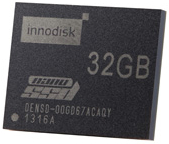Innodisk Produces Industrial-Embedded nanoSSD SATA Device
That conforms to JEDEC's standard (MO-276)
This is a Press Release edited by StorageNewsletter.com on February 24, 2014 at 3:01 pmInnodisk Corp. announces the full-rate production of a nanoSSD SATA device that conforms to JEDEC’s standard (MO-276).
The company integrates a flash control chip, NAND flash, and ball grid array (BGA) package to deliver a nanoSSD that is approximately 1% of the size (16x20x2mm) of a 2.5″ SSD, by volume. The product weighs 1.5 grams, supports the SATA III interface, and is compatible with both x86 and ARM systems.
nanoSSDs are being incorporated into applications where small form-factors and high transfer rates are critical, including industrial mobile devices, point-of-sale systems, embedded products, tablets, ultrabooks, and high-end smart phones.
In addition to its slim form factor, the nanoSSD offers data transfer speeds by reading up to 500MB/s and writing up to 170MB/s.
Whether it’s storage, system boot, data cache backup, or all three, Innodisk’s nanoSSD answers those challenges with efficiency and performance.
The nanoSSDs are manufactured in compliance with wide-temperature operating range (-40?C to +85?C), shock-resistance, quick erase features, and ATA security.
Innodisk’s nanoSSD was built with an open architecture in mind, enabling developers to create innovative designs with performance. Additionally, Innodisk stands behind its Absolute Service pledge to provide professional engineering support to customers during their design, testing, and system support phases.
Innodisk provides the iSMART monitoring tool free of charge, thus extending a network of data gathering tools that enable a deeper understanding of long term product performance parameters and shape the next generation product solutions for customers. It allows users to visualize SSD wear-leveling characteristics with a graphical display, giving users time to replace degrading disks long before they exhibit severe performance issues.
Industry Forecast
According to DRAMeXchange, a research division of TrendForce, SSD NAND flash consumption will continue to rise from 2013’s 13% jump to 25% in 2014. The growth is likely to be higher in SSD technologies compared to other NAND flash products. In the long run, NAND Flash applications will become increasingly more diverse. In addition to the attachment type UFDs, memory cards, and system products such as smartphones and tablets, an increasing amount of attention is being placed on industry-level storage systems. Along with the effects of the manufacturers’ supply regulations, TrendForce believes the end-demand for multi-purpose products will enable NAND Flash markets to grow at a more stable pace throughout 2014. On the whole, the industry’s supply and demand is expected to remain healthy.















 Subscribe to our free daily newsletter
Subscribe to our free daily newsletter

